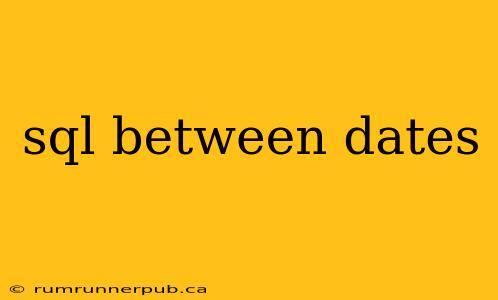Selecting data within specific date ranges is a fundamental task in SQL. The BETWEEN operator provides a concise and efficient way to achieve this, but understanding its nuances and potential pitfalls is crucial. This article explores the use of BETWEEN with dates in SQL, drawing insights from Stack Overflow discussions and adding practical examples and best practices.
Understanding the BETWEEN Operator for Dates
The BETWEEN operator in SQL simplifies the selection of data falling within a given range, inclusive of both the start and end values. When working with dates, this translates to selecting all rows where a date column falls on or between two specified dates.
Basic Syntax:
SELECT column1, column2, ...
FROM table_name
WHERE date_column BETWEEN date1 AND date2;
Example (based on a Stack Overflow discussion):
Let's imagine a table named orders with columns order_id (INT), order_date (DATE), and order_amount (DECIMAL). We want to find all orders placed between January 1st, 2023, and March 31st, 2023.
SELECT order_id, order_date, order_amount
FROM orders
WHERE order_date BETWEEN '2023-01-01' AND '2023-03-31';
(Inspired by numerous Stack Overflow questions regarding date range selection using BETWEEN)
Important Note: The date format used ('YYYY-MM-DD') is crucial and depends on your database system's settings. Inconsistent date formats will lead to errors. Always consult your database's documentation for the correct format.
Handling Time Components
A common source of confusion arises when dealing with DATETIME or TIMESTAMP columns, which include time components in addition to the date. BETWEEN considers the entire value, including the time.
Example:
If order_date is a DATETIME column, BETWEEN '2023-01-01' AND '2023-03-31' will only include entries where the time component is 00:00:00. To include all entries within the specified date range, regardless of the time, we need a more nuanced approach.
Solution (inspired by Stack Overflow solutions addressing time components):
We can use comparison operators to create a more flexible range.
SELECT order_id, order_date, order_amount
FROM orders
WHERE order_date >= '2023-01-01 00:00:00' AND order_date < '2023-04-01 00:00:00';
This approach is generally preferred for DATETIME and TIMESTAMP columns as it avoids potential ambiguity. We are explicitly including the entire day of '2023-01-01' and excluding the entire day of '2023-04-01'.
Advanced Date Range Queries
For more complex scenarios, you may need to combine BETWEEN with other SQL functions and clauses.
Example: Finding orders in the last 30 days:
SELECT order_id, order_date, order_amount
FROM orders
WHERE order_date BETWEEN DATE('now', '-30 days') AND DATE('now');
(This example utilizes SQLite's DATE function. The equivalent function might vary depending on your database system – e.g., DATE_SUB in MySQL, DATEADD in SQL Server.)
This query dynamically calculates the date range, making it adaptable to different execution times. Remember to replace DATE('now', '-30 days') and DATE('now') with the appropriate functions for your specific SQL dialect.
Conclusion
The BETWEEN operator offers a straightforward way to query data within date ranges in SQL. However, understanding the implications of time components and leveraging alternative strategies for more complex scenarios are vital for writing robust and accurate SQL queries. This article, combining insights from Stack Overflow discussions and adding practical examples, aims to equip you with the knowledge to handle various date range selection tasks effectively. Remember always to consult your database system's documentation for specific date formatting and function usage.
